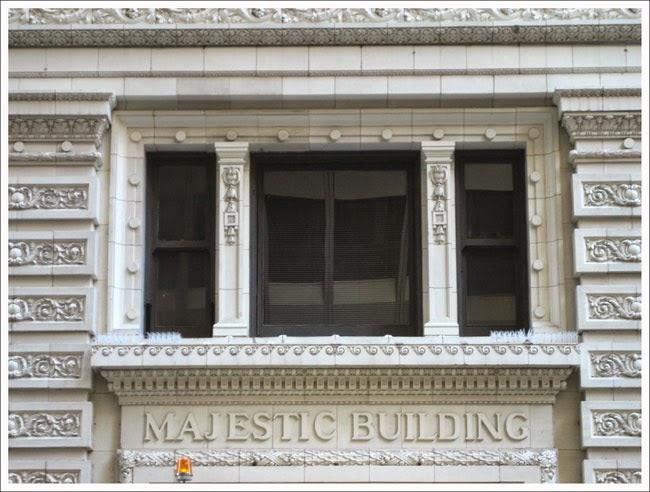Majestic Theatre Building - Bank Of America Theatre
by: chicago designslinger
[Majestic Theatre Building - Bank of America Theatre (1906) Edmund R. Krause, architect; C.W. & George L. Rapp, associates /Image & Artwork: chicago designlinger]
"Chicago has a new vaudeville theater and it is a beauty," gushed the Chicago Tribune on January 2, 1906. Not only was the theater a beaut, but at 20-stories, architect Edmund Krause's ornately decorated Majestic Building was Chicago's tallest structure. It was also the first public auditorium built in the city following the horrific Iroquois Theatre fire that claimed the lives of over 700 matinee attendees in 1903. As a result of that disastrous event Chicago had the strictest fire regulations in the country, and the Majestic Theatre was the first to be built under those new stringent standards.
[Majestic Theatre Building - Bank of America Theatre, 22 W. Monroe Street, Chicago /Image & Artwork: chicago designslinger]
The building sat on a piece of land owned by the Chicago School Board. When the federal government had a survey map of the future city drawn-up in the early 1830s, Block 142 - between Madison Street, Monroe, Dearborn, and the western line of the U.S. Reservation (today's State Street) - was designated the School Reservation block. The commissioners who were overseeing the construction of the Illinois & Michigan Canal set aside sections of land to be sold by the government to raise money for the public works project, and "reserved" a few parcels for a non-existent school district as a way to finance future public education.
[Majestic Theatre Building - Bank of America Theatre, Chicago /Image & Artwork: chicago designslinger]
Eventually the school block was divided into individual lots fronting Dearborn and State, and tucked in between, three narrow 27-foot-wide lots fronting Madison and Monroe. In 1857 McVicker's Theatre opened on the three Madison Street facing lots - where a McVicker's named theater building stood until 1985 -whose back lot-line butted-up against the three narrow lots facing Monroe Street. Augusta Lehmann, who with her husband Ernest J. had founded one of the city's largest department stores The Fair, had taken a 99-year leasehold on the property in 1901 for which the Lehmann estate would pay the Board of Education $27,000 per annum. The property already had three 4-story, post-1871-fire, buildings standing on it which Augusta purchased, and in 1904 she had then demolished and hired Krause to design a modern, $1.3 million, income-producing office tower and theater.
[Majestic Theatre Building - Bank of America Theatre, Chicago Downtown Theatre District /Image & Artwork: chicago designslinger]
Vaudeville was the nation's most popular form of entertainment at the turn of the 20th century, and the new Majestic would be the city's premiere vaudeville house. The office space directly above the ground floor became of the home office of the Western Vaudeville Managers Association. The theater's opening bill included performances by the "8 Allsions" an acrobatic act, magician "Hermann the Great," and jugglers "Redford & Winchester." By the late 1920s as vaudeville's popular appeal was overtaken by motion pictures the theater fell on hard times, while the office portion of the building continued to generate revenue for the Lehmann estate.
[Majestic Theatre Building - Bank of America Theatre /Image & Artwork: chicago designslinger]
Augusta's heirs had an even harder time finding anyone interested in leasing the theater once the Great Depression took hold, and the beautiful auditorium sat vacant and unused for eleven years. Then in 1945 New York's Shubert organization stepped, and for $350,000 purchased the building and leasehold from the Lehmann's, and for the next 44 years the east coast producers brought Broadway productions to Chicago in the renamed the Shubert Theatre. By the early 1990's the organization, which once operated 7 theaters in the city, sold the property to their New York rivals the Nederlander's for $750,000. By that time the office portion of the aging structure was mostly vacant, and in 2005 the Nederlander group closed the building, renovated the theater, and converted the office space into a hotel managed by the Hampton Inn franchise. The naming rights to the theater were sold to a bank.





No comments:
Post a Comment
Note: Only a member of this blog may post a comment.